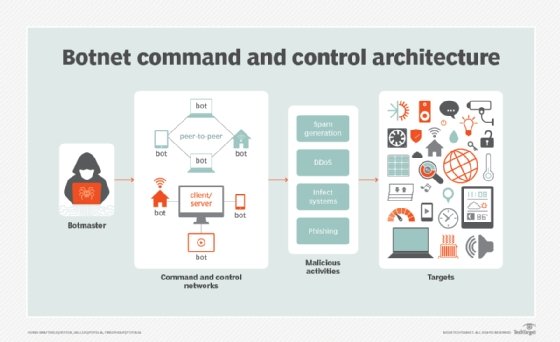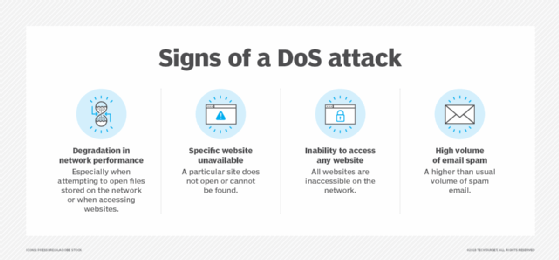How To Stop Denial Of Service Attack
What is a DDoS set on?
In a distributed denial-of-service (DDoS) set on, multiple compromised computer systems attack a target and cause a denial of service for users of the targeted resources. The target can exist a server, website or other network resource. The inundation of incoming letters, connection requests or malformed packets to the target system forces it to dull downwards or even crash and close downwardly, thereby denying service to legitimate users or systems.
Many types of threat actors, ranging from individual criminal hackers to organized crime rings and government agencies, carry out DDoS attacks. In certain situations -- often ones related to poor coding, missing patches or unstable systems -- fifty-fifty legitimate, uncoordinated requests to target systems can look similar a DDoS attack when they are just coincidental lapses in system performance.
How do DDoS attacks piece of work?
In a typical DDoS attack, the attacker exploits a vulnerability in one computer system, making it the DDoS principal. The set on master system identifies other vulnerable systems and gains control of them by infecting them with malware or bypassing the hallmark controls through methods like guessing the default password on a widely used system or device.
A reckoner or network device nether the control of an intruder is known equally a zombie, or bot. The aggressor creates what is chosen a command-and-control server to control the network of bots, as well called a botnet. The person in control of a botnet is referred to as the botmaster. That term has too been used to refer to the first system recruited into a botnet because it is used to control the spread and activity of other systems in the botnet.
Botnets tin can exist composed of almost any number of bots; botnets with tens or hundreds of thousands of nodes have become increasingly common. There may not be an upper limit to their size. Once the botnet is assembled, the attacker tin can utilize the traffic generated by the compromised devices to flood the target domain and knock it offline.
The target of a DDoS assault is not e'er the sole victim considering DDoS attacks involve and affect many devices. The devices used to route malicious traffic to the target may also suffer a deposition of service, even if they aren't the main target.

Types of DDoS attacks
There are iii main types of DDoS attacks:
- Network-centric or volumetric attacks. These overload a targeted resource by consuming available bandwidth with package floods. An case of this type of attack is a domain name system amplification attack, which makes requests to a DNS server using the target's Internet Protocol (IP) address. The server and so overwhelms the target with responses.
- Protocol attacks. These target network layer or transport layer protocols using flaws in the protocols to overwhelm targeted resources. A SYN flood attack, for instance, sends the target IP addresses a high volume of "initial connexion request" packets using spoofed source IP addresses. This drags out the Transmission Control Protocol handshake, which is never able to finish because of the constant influx of requests.
- Application layer . Here, the application services or databases get overloaded with a loftier book of application calls. The inundation of packets causes a denial of service. I instance of this is an Hypertext Transfer Protocol (HTTP) flood attack, which is the equivalent of refreshing many webpages over and over simultaneously.
Cyberspace of things and DDoS attacks
The devices constituting the internet of things (IoT) may be useful to legitimate users, but in some cases, they are even more helpful to DDoS attackers. The IoT-continued devices include any appliance with built-in computing and networking chapters, and all too frequently, these devices are non designed with security in mind.
IoT-connected devices betrayal large attack surfaces and often pay minimal attention to security best practices. For instance, devices are oftentimes shipped with hardcoded hallmark credentials for system administration, making it simple for attackers to log in to the devices. In some cases, the authentication credentials cannot be changed. Devices also often ship without the capability to upgrade or patch the software, further exposing them to attacks that use well-known vulnerabilities.
IoT botnets are increasingly being used to wage massive DDoS attacks. In 2016, the Mirai botnet was used to set on the domain name service provider Dyn; attack volumes were measured at over 600 gigabits per second. Another late 2016 attack unleashed on OVH, the French hosting business firm, peaked at more than than one terabit per 2d. Many IoT botnets since Mirai apply elements of its code. The dark_nexus IoT botnet is one example.
Identifying DDoS attacks
DDoS attack traffic essentially causes an availability event. Availability and service issues are normal occurrences on a network. It'due south important to be able to distinguish between those standard operational issues and DDoS attacks.
Sometimes, a DDoS attack can await mundane, and so it is important to know what to look for. A detailed traffic analysis is necessary to first decide if an assail is taking place and then to determine the method of attack.
Examples of network and server behaviors that may indicate a DDoS attack are listed beneath. One or a combination of these behaviors should raise business concern:
- I or several specific IP addresses make many consecutive requests over a brusk period.
- A surge in traffic comes from users with similar behavioral characteristics. For example, if a lot of traffic comes from users of a similar devices, a single geographical location or the aforementioned browser.
- A server times out when attempting to examination information technology using a pinging service.
- A server responds with a 503 HTTP error response, which means the server is either overloaded or down for maintenance.
- Logs show a strong and consequent spike in bandwidth. Bandwidth should remain fifty-fifty for a normally functioning server.
- Logs evidence traffic spikes at unusual times or in a usual sequence.
- Logs show unusually big spikes in traffic to 1 endpoint or webpage.
These behaviors can too help determine the type of set on. If they are on the protocol or network level-- for example, the 503 mistake -- they are probable to be a protocol-based or network-centric attack. If the beliefs shows up as traffic to an awarding or webpage, it may be more indicative of an awarding-level attack.
In almost cases, it is incommunicable for a person to track all the variables necessary to determine the type of set on, then information technology is necessary to use network and application assay tools to automate the process.

DDoS defence force and prevention
DDoS attacks tin create meaning business organization risks with lasting furnishings. Therefore, information technology is important to understand the threats, vulnerabilities and risks associated with DDoS attacks.
Once underway, it is about impossible to stop these attacks. However, the business touch of these attacks can be minimized through some core information security practices. These include performing ongoing security assessments to look for and resolve DoS-related vulnerabilities and using network security controls, including services from cloud service providers specializing in responding to DDoS attacks.
In add-on, solid patch management practices, email phishing testing and user awareness, and proactive network monitoring and alerting tin help minimize an organisation's contribution to DDoS attacks across the internet.
Examples of DDoS attacks
Besides the IoT-based DDoS attacks mentioned earlier, other recent DDoS attacks include the following:
- A 2018 attack on GitHub is said to be the biggest DDoS set on to date. The assault sent massive amounts of traffic to the platform, which is used past millions of developers to postal service and share code.
- A volumetric DDoS attack targeted New Zealand's Exchange in 2020, forcing information technology to go offline for several days.
- In 2019, Prc's Great Cannon DDoS operation targeted a website used to organize pro-democracy protests in Hong Kong, causing traffic congestion on the site. DDoS attacks are oftentimes used in social movements, not just by hackers, only also by hacktivists and authorities-affiliated organizations. DDoS attacks are a good way to direct public attention at a specific group or cause.
- Too in 2020, threat thespian groups Fancy Carry and Armada Collective threatened several organizations with DDoS attacks unless a bitcoin ransom was paid. This is an case of how DDoS attacks and ransomware are used in tandem.
Although DDoS attacks are relatively cheap and easy to implement, they vary widely in complexity and can accept a astringent affect on the businesses or organizations targeted. Acquire how businesses can forestall these attacks by buying a service from an internet access provider, using a content commitment network and deploying an in-house intrusion prevention system.
This was terminal updated in June 2021
Keep Reading Most distributed denial-of-service (DDoS) attack
- How an IoT botnet attacks with DDoS and infects devices
- Ransom DDoS attacks on the rise
- DDoS attacks among top 5G security concerns
- Record-setting DDoS attacks signal troubling tendency
- Exercise network layer and awarding layer DDoS attacks differ?
Dig Deeper on Network security
-
![]()
Attackers enlist cloud providers in large HTTPS DDoS hit
-

denial-of-service attack
-

botnet
-

How an IoT botnet attacks with DDoS and infects devices
How To Stop Denial Of Service Attack,
Source: https://www.techtarget.com/searchsecurity/definition/distributed-denial-of-service-attack
Posted by: kinghistorl.blogspot.com







0 Response to "How To Stop Denial Of Service Attack"
Post a Comment